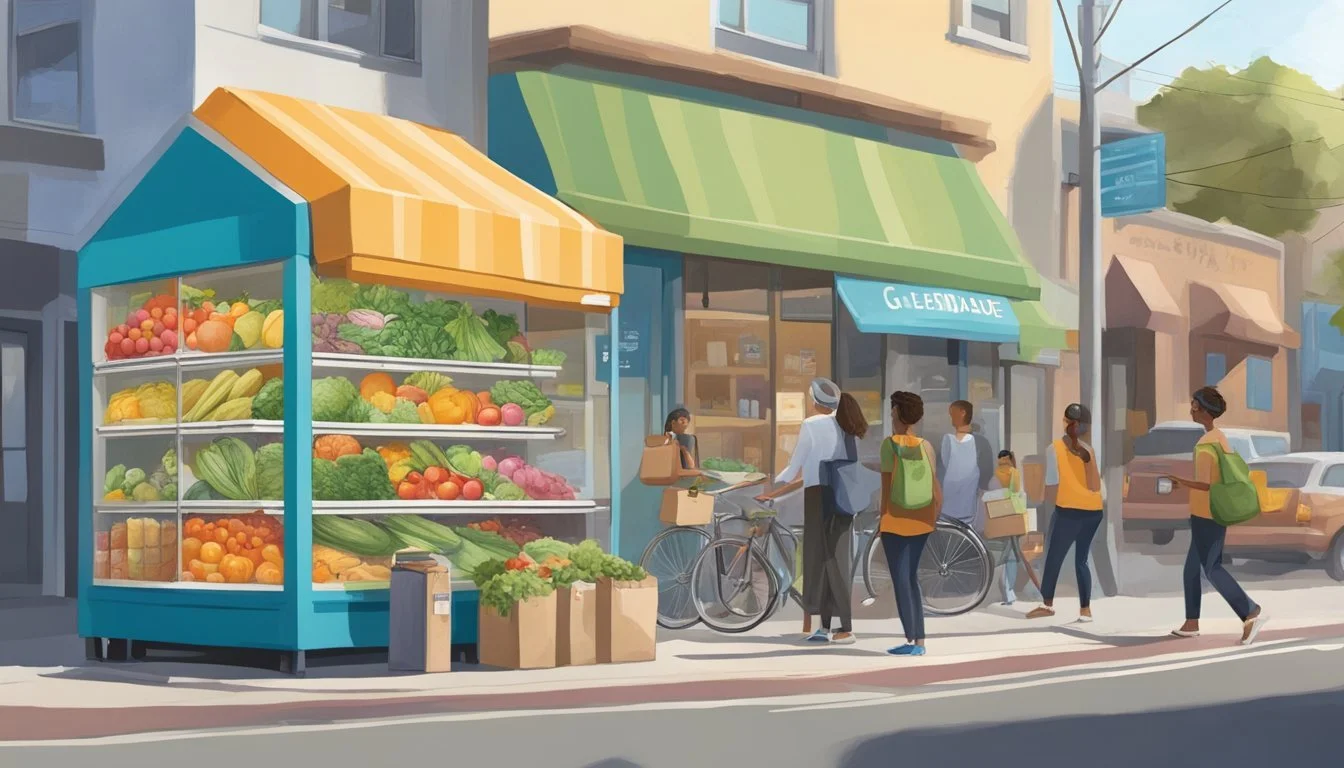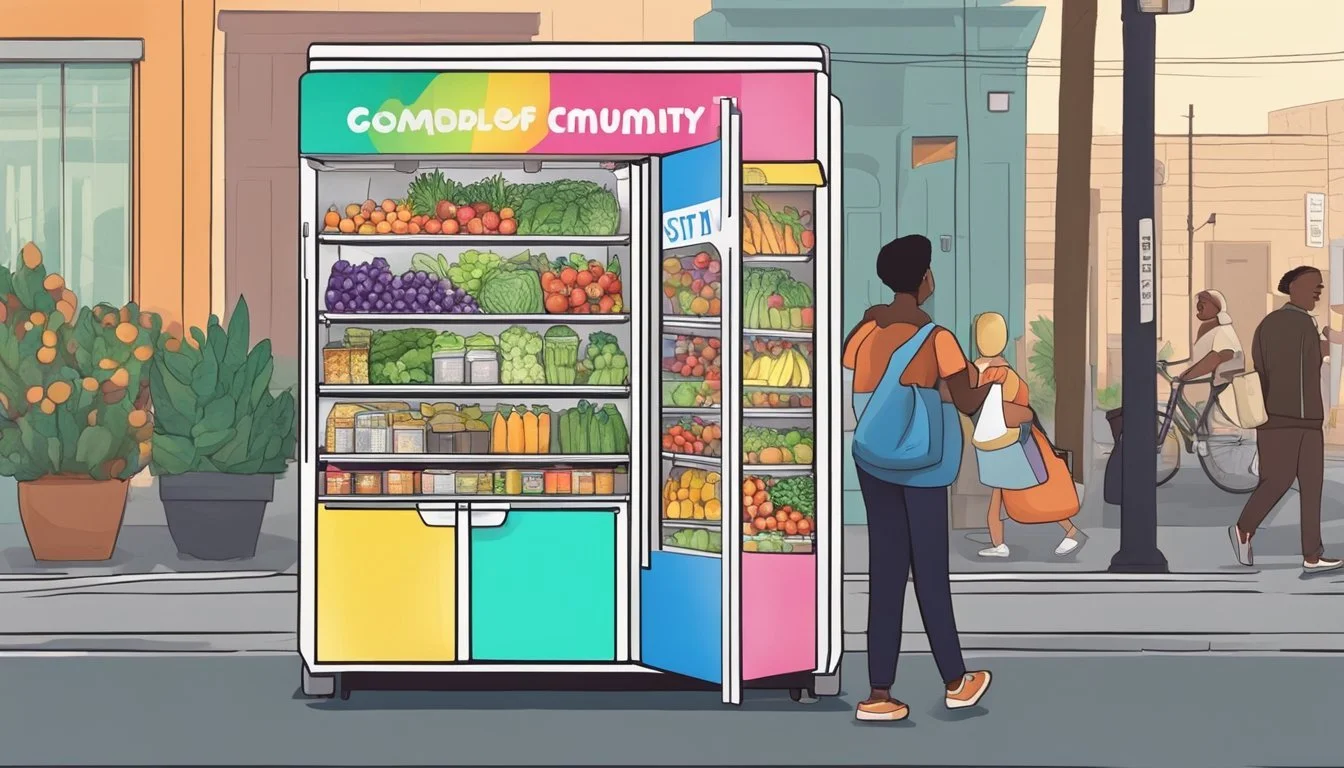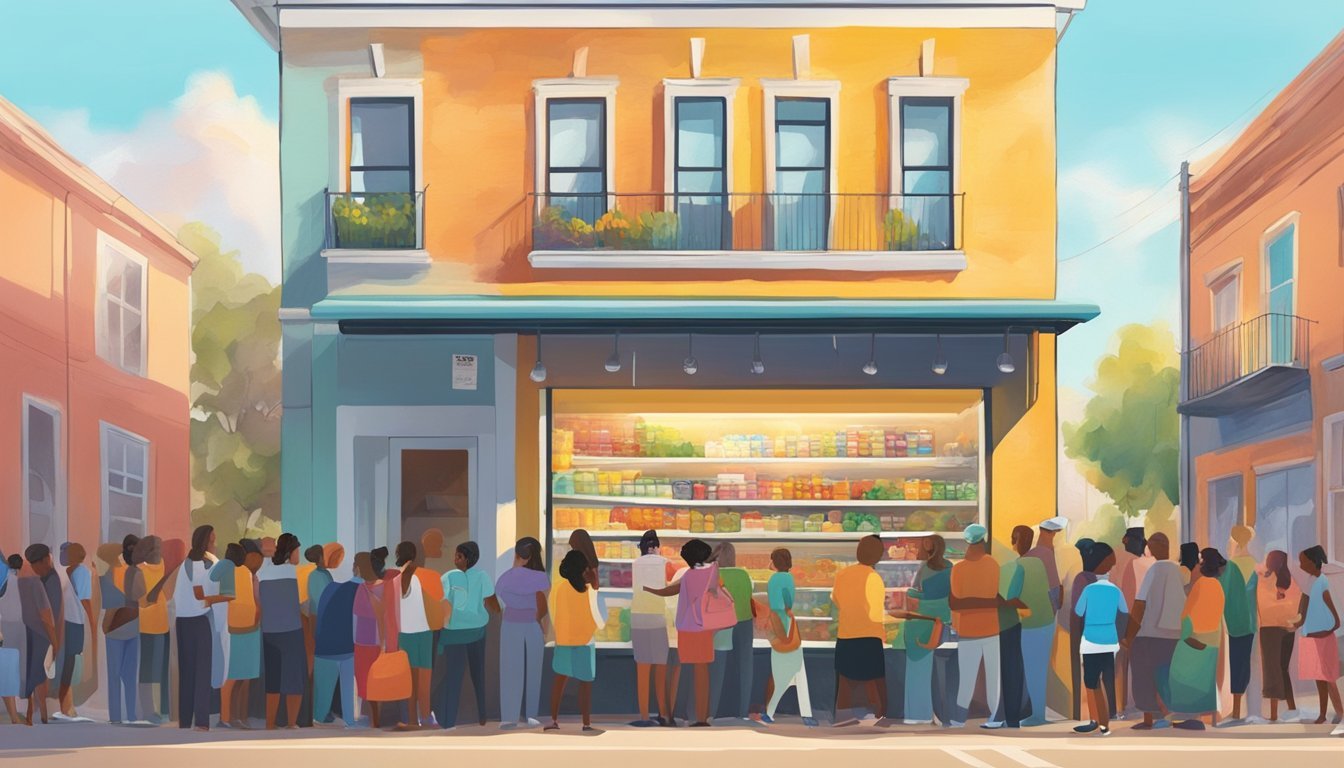Glendale, CA Community Fridge
Nurturing Neighborhood Solidarity Through Sharing
The concept of community fridges has taken root in Glendale, California, embodying a practical approach to addressing food insecurity while also mitigating food waste. Located in publicly accessible areas, these refrigerators are stocked with perishable surplus food, available to anyone in need. They operate on an honor system, ensuring that the local community can both contribute to and benefit from the shared resource.
Volunteers play a pivotal role in the success of the Glendale Community Fridge, facilitating the smooth operation and maintaining the flow of donations. By fostering a spirit of sharing and collective responsibility, the project not only provides food but also strengthens community bonds. Businesses, organizations, and private citizens come together in a collaborative effort, showcasing how shared initiative can create a sustainable impact on a local scale.
Through the collective work of volunteers and the local community's engagement, the Glendale Community Fridge represents an innovative model for local empowerment and social support. It serves as a tangible example of how communities can mobilize resources to ensure equitable access to nutritious food while promoting environmental sustainability through the reduction of waste.
Community Fridge Concept and Purpose
Community fridges in Glendale, CA, serve as a grassroots solution to food insecurity and waste, emphasizing the role of community in resource sharing and sustainability.
Understanding Community Fridges
Community fridges are refrigerators placed in public spaces where individuals and organizations can leave perishable food for others to use. They operate on an honor system, and anyone can contribute donations or take what they need, fostering a sense of collective responsibility and mutual aid within the community. Glendale's Community Fridge, for example, is a node in this network of shared resources aimed at strengthening communal ties and promoting an egalitarian approach to food distribution.
Role in Food Security
The concept of a community fridge directly targets the issue of food security. By providing free and easy access to food, these fridges help ensure that members of the community have a reliable source of nutrients. They particularly benefit individuals and families who face economic challenges or unexpected hardship, supplementing their dietary intake without cost barriers.
Addressing Food Insecurity
Addressing food insecurity cannot be done in isolation—it requires a sustainable strategy. Community fridges not only distribute food but also actively reduce food waste. Surplus foods from households, farms, and businesses—which would otherwise be discarded—find a second life as valuable donations to those in need. Glendale's initiative illustrates this purposeful redirection that supports both environmental sustainability and social welfare.
Glendale's Community Fridge Initiative
The Community Fridge in Glendale, California, serves as a hub for reducing food waste and providing accessible perishable goods to local residents. The initiative operates on a foundation of trust, community engagement, and sustainability.
How It Started
The concept of the community fridge in Glendale was inspired by similar successful projects that had emerged in other cities, such as New York. Local volunteers, driven by a desire to combat food insecurity, collaborated to establish a system that could offer surplus food to those in need. They sought the support of local businesses and organizations to provide a steady supply of food items.
Current Impact
Since its inception, Glendale's Community Fridge has had a significant impact on both the environment and the local community. It has been instrumental in redistributing 12 tons of food that would have otherwise been wasted. In monetary terms, this represents over $10,000 in savings for households and community groups. The Community Fridge has not only provided access to free food around the clock but has also contributed to local employment opportunities.
Local Involvement
Local businesses, organizations, and individuals in Glendale play a crucial role in maintaining the fridge's inventory. They ensure it is stocked with a varied selection of foods, such as:
Prepackaged salads
Fresh produce (e.g., heirloom tomatoes, fresh herbs)
Dairy products (e.g., eggs)
Beverages
Los Angeles County supports these efforts, showcasing a collective endeavor to sustain this community resource. The fridge, often decorated with art, stands as a testament to the community spirit, inviting everyone to participate, contribute, or take what they need.
Logistics and Operations
The Glendale, CA Community Fridge operates on a robust system designed to ensure that surplus perishable food is efficiently redistributed to the community while adhering to rigorous safety standards.
Sourcing and Donation Process
The Community Fridge relies on donations from local grocers, restaurants, and community members to stock its shelves with fresh food. Donations are accepted during specified hours to ensure that food items are fresh upon receipt. They emphasize the procurement of a variety of hygiene products alongside perishable food items to meet diverse community needs. Volunteers play a crucial role in this process, aiding in the transportation and sorting of donated items.
Food Collection: Volunteers collect surplus food and hygiene products.
Donation Times: Designated for drop-off to maintain freshness.
Food Types: Emphasis on fresh, wholesome items suitable for immediate distribution.
Maintenance and Safety Protocols
Maintenance of the fridge involves regular cleaning and temperature checks to guarantee that the food remains safe for consumption. Safety protocols are in place to ensure that all donations meet hygiene and safety standards before they are made available to the public. Volunteers regularly monitor the state of the fridge, removing any items that do not adhere to these standards.
Daily Checks: Volunteers perform routine inspections for cleanliness and safety.
Hygiene Enforcement: Strict adherence to guidelines to maintain health standards.
Temperature Control: Constant monitoring to keep food in optimal conditions.
By streamlining the donation process and enforcing stringent maintenance and safety protocols, the Glendale Community Fridge works towards its goal of reducing food waste and providing for those in need with dignity and respect.
Public Engagement and Volunteering
In Glendale, community fridge initiatives thrive on active public participation and the altruistic efforts of volunteers. These programs aim to strengthen communal bonds and address food insecurity.
Volunteer Roles and Responsibilities
Volunteers play a critical role in the operation of community fridges. Their responsibilities include:
Food Redistribution: They ensure that surplus perishable items are stocked in the fridges and made available to all.
Maintenance: Regular cleaning and monitoring of the fridge conditions fall under their purview to maintain hygiene standards.
Advocacy: Volunteers often take to platforms like Instagram to raise awareness and support for the cause.
Coordination: They coordinate with local businesses and organizations to secure food donations.
Community Outreach
The success of a community fridge is closely tied to its visibility and accessibility:
Location: The fridges are placed in accessible public spaces. A map is typically available to guide community members to the nearest fridge site.
Education: Outreach efforts educate the public on how to participate, emphasizing the honor system that these fridges operate on.
Inclusion: Special needs accommodations are provided to ensure everyone in the community can partake in and benefit from the initiative.
Partnerships and Support Systems
The Glendale Community Fridge initiative flourishes due to a strong network of support from local businesses and collaborations with government and nonprofit organizations. This synergy helps ensure sustainable operations and benefits the local community directly.
Local Business Contributions
Local businesses play a crucial role in supporting the Community Fridge initiative. They contribute in several ways, from donating excess food to providing logistical support. These contributions not only reduce food waste but also help meet the nutritional needs of the community members in Glendale. For instance:
Restaurants and Grocers: Donate surplus produce and prepared meals.
Hardware Stores: Offer maintenance supplies for the physical upkeep of the fridges.
Government and Nonprofit Collaboration
Partnerships with government entities and nonprofit organizations are instrumental in expanding the reach and impact of the Community Fridge project.
Government Support: Local government agencies can facilitate permits and provide locations for fridge placements, ensuring they operate in compliance with city regulations.
Nonprofit Involvement: Charities and community organizations often provide food, financial backing, and volunteers. This joint effort amplifies the initiative's capability to serve a larger section of the populace and maintain a steady flow of resources.
Benefits and Challenges of Community Fridges
Community fridges in Glendale, CA bring to light innovative solutions to food insecurity and environmental concerns. However, they also face a set of challenges that need to be addressed to ensure their sustainability and effectiveness.
Environmental and Social Impact
Food waste is a prevalent issue with far-reaching environmental implications. The EPA has identified food waste as a significant contributor to landfill mass, which in turn affects climate change due to the release of greenhouse gases during decomposition. In combatting food waste, community fridges provide a dual benefit: they redirect surplus food that is still consumable away from landfills, and they serve as a free resource for individuals facing food insecurity.
Reduction in food waste: Community fridges help to mitigate the amount of edible food dumped into landfills.
Assistance to those in need: These fridges ensure that vulnerable members of the community have access to free, nutritious food.
Glendale's community fridge, for instance, has been instrumental in both redistributing tons of food waste and in providing considerable savings to households in terms of food costs. This initiative reflects a growing cultural shift towards community-led efforts to ensure no one goes hungry while also safeguarding the environment.
Common Obstacles
Despite the positive impact, community fridges encounter several obstacles:
Sustainability: Maintaining a steady supply of quality donations and the ongoing operation costs can be a challenge.
Safety and regulation: Ensuring the safety of the food provided is paramount. The fridge must adhere to strict health guidelines to prevent the spread of foodborne illnesses.
Public engagement: For a community fridge to thrive, it needs high community engagement for both stocking and utilizing the fridge.
The Glendale community fridge operates on an honor system which inherently trusts individuals to take what they need and contribute when they can. Issues such as vandalism or misuse can pose significant roadblocks to the success of these fridges. Continuous community education and engagement are crucial in overcoming these challenges, helping to foster a culture of sharing and preventing potential misuse.
Future of Community Fridges in Glendale
Community Fridges in Glendale are poised for a sustainable future with potential technological advancements enhancing their impact. These initiatives are expected to address food insecurity while embracing environmental benefits.
Sustainability and Expansion
Sustainability plays a critical role in the longevity of the Community Fridge network. In Glendale, the movement has already demonstrated success by redistributing surplus perishable food, significantly reducing food waste, and offering cost savings to the community. Expansion is the logical next step, potentially involving a wider network of fridges and a greater variety of nutritious food options. The aim is to not only increase the number of fridges but also enhance the collective effort of businesses, organizations, and individuals to maintain a consistent food supply.
Goals for Expansion:
Increase the number of community fridges throughout Glendale.
Forge partnerships with more local businesses and organizations.
Boost community involvement and volunteer numbers.
Technological Integration
The integration of technology can be a transformative factor for community fridges. Data technology, for example, can track inventory levels, offer real-time updates on food availability, and efficiently manage distribution. It's envisioned that such advancements would allow the community to optimize food sharing and to better meet the needs of residents. Potential technological projects could include:
An app to locate fridges and their contents.
A system to monitor food freshness and safety.
Data analytics to predict and manage food stock based on community needs.
Technology inclusion is anticipated to make the community fridge network more efficient, cutting down on waste even further and ensuring that as many people as possible benefit from the initiative.
Additional Resources
The Glendale Community Fridge provides access to food and resources aimed at reducing food waste and insecurity. It emphasizes community involvement through the availability of food and education.
Educational Material
Glendale Community Fridge initiatives are supported by education on food sustainability and secure access. Feeding America, a nationwide network, offers valuable insights and learning resources that help communities understand the importance of food rescue and assistance programs.
Educational Content:
Food waste prevention techniques
Nutritional information
Safe food handling practices
Local workshops and online courses can equip community members with the knowledge necessary for maintaining and utilizing a community fridge effectively.
Online Platforms and Networks
Freedge serves as an online hub where communities can learn about installing and operating a community fridge. Users are provided with a step-by-step guide and resources such as:
Installation process
Maintenance tips
Health and safety guidelines
The platform connects individuals with an interactive map, listing various community fridge locations across neighborhoods, including those in the LA Community Fridges network. This assists residents in locating their nearest fridge or learning how to contribute to existing ones.
Community Involvement Channels:
Website directories
Social media groups
These online resources and networks play a crucial role in the education and expansion of community fridge projects, fostering a supportive environment for their continuous growth and positive impact on food security in Glendale.










